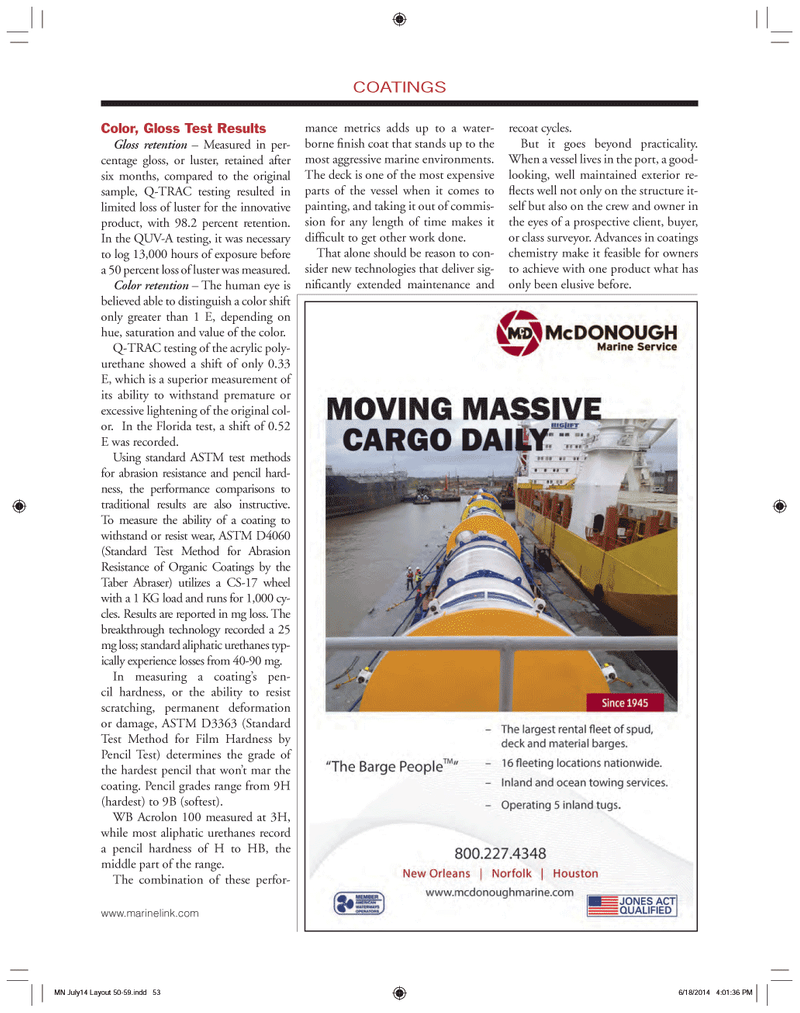
Page 53: of Marine News Magazine (July 2014)
ATB Technical Trends
Read this page in Pdf, Flash or Html5 edition of July 2014 Marine News Magazine
Color, Gloss Test Results Gloss retention ? Measured in per- centage gloss, or luster, retained after six months, compared to the original sample, Q-TRAC testing resulted in limited loss of luster for the innovative product, with 98.2 percent retention. In the QUV-A testing, it was necessary to log 13,000 hours of exposure before a 50 percent loss of luster was measured. Color retention ? The human eye is believed able to distinguish a color shift only greater than 1 E, depending on hue, saturation and value of the color. Q-TRAC testing of the acrylic poly- urethane showed a shift of only 0.33 E, which is a superior measurement of its ability to withstand premature or excessive lightening of the original col- or. In the Florida test, a shift of 0.52 E was recorded. Using standard ASTM test methods for abrasion resistance and pencil hard- ness, the performance comparisons to traditional results are also instructive. To measure the ability of a coating to withstand or resist wear, ASTM D4060 (Standard Test Method for Abrasion Resistance of Organic Coatings by the Taber Abraser) utilizes a CS-17 wheel with a 1 KG load and runs for 1,000 cy- cles. Results are reported in mg loss. The breakthrough technology recorded a 25 mg loss; standard aliphatic urethanes typ- ically experience losses from 40-90 mg. In measuring a coating?s pen- cil hardness, or the ability to resist scratching, permanent deformation or damage, ASTM D3363 (Standard Test Method for Film Hardness by Pencil Test) determines the grade of the hardest pencil that won?t mar the coating. Pencil grades range from 9H (hardest) to 9B (softest). WB Acrolon 100 measured at 3H, while most aliphatic urethanes record a pencil hardness of H to HB, the middle part of the range. The combination of these perfor- mance metrics adds up to a water-borne nish coat that stands up to the most aggressive marine environments. The deck is one of the most expensive parts of the vessel when it comes to painting, and taking it out of commis-sion for any length of time makes it dif cult to get other work done. That alone should be reason to con- sider new technologies that deliver sig- ni cantly extended maintenance and recoat cycles. But it goes beyond practicality. When a vessel lives in the port, a good- looking, well maintained exterior re- ects well not only on the structure it- self but also on the crew and owner in the eyes of a prospective client, buyer, or class surveyor. Advances in coatings chemistry make it feasible for owners to achieve with one product what has only been elusive before. COATINGS www.marinelink.com MN July14 Layout 50-59.indd 53MN July14 Layout 50-59.indd 536/18/2014 4:01:36 PM6/18/2014 4:01:36 PM

 52
52

 54
54
